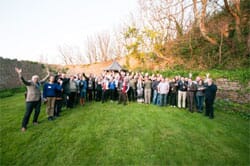The workshop had 3 high level aims:
- To examine scallop management in the channel, including challenges to success and opportunities to improve current management.
- To bring together a wide range of participants from all coastal Member States concerned about Channel scallop management (predominantly France, UK – England, Scotland, Wales, Isle of Man, Ireland, Netherlands and Belgium) to discuss future management options through a participatory process.
- To provide an inclusive and participative forum to engage industry in the design and management of their fishery and identify potential opportunities to strengthen the existing management framework, improve the scientific knowledge base, and develop long-term goals to deliver a profitable, sustainable fishery compliant with both MSFD and CFP policy objectives.

The workshop was attended by a diverse group of more than 60 participants across industry (including fishermen and their representatives, quota managers, supply chain), government, academia, and environmental organisations. Discussions were lively and participants all exchanged ideas on what the future could be for a prosperous and sustainable channel scallop fishery.
The workshop had several desired outcomes, including:
- Increased trust between different stakeholders
- Shared understanding of the challenges and opportunities for scallop fishermen
- Greater awareness of different perspectives on scallop management in the channel
- A number of ideas for improvements to develop further
- Proposed date and venue for a follow up event in France
The workshop achieved these overarching aims and outcomes and the following outputs were documented by the GAP team:
- Improved data is vital to the long-term, sustainable future for the fishery. Currently stock and capacity data is poor, which would act as a barrier to developing a coherent regional management plan in the future.
- Fishers would welcome the opportunity to support scientific studies directed towards a full scallop stock assessment. Greater resources should be directed towards this kind of participatory scientific research.
- A full capacity assessment of scallop boats operating in the Channel should be undertaken.
- Particular attention should be paid to ICES area VIId, including the harmonisation of technical measures. This will require further discussion to reach consensus.
- All measures must be driven, bottom-up, by industry. Whilst this is already broadly the case in France, in the UK greater emphasis should be placed on fishers’ potential contribution to management planning and decisions.
- The establishment of a dedicated working group, with a specific focus on the Channel scallop fishery, would be beneficial to moving forward with agreed suggestions – potentially facilitated through the NWWAC’s current Channel working group.
A more detailed roundup of the event can be found here: http://gap2.eu/gap2voices/channel-scallop-fishery-collaborating-for-a-sustainable-future/
The workshop was run by a team of facilitators that guided participants through a range of exercises and discussion groups throughout the two day event. Presentations covered a range of topics on science, monitoring and data collection, management, markets and industry perspectives. A full list of presentations can be accessed here: http://gap2.eu/gap2general/gap2-scallops-workshop-the-presentations-les-presentations/
The facilitated exercises included unstructured sessions such as the ‘getting to know you’ exercise to more structured breakout groups, including a SWOT (Strenghts, Weaknesses, Opportunities and Threats) exercise which helped participants identify key areas and issues they would like to see addressed in the next 2 – 3 years (see Annex A for the detailed SWOT).
The priority areas were then grouped in themes and participants were divided in smaller breakout groups to discuss each theme in greater detail. These themes are set out in section 1 of the report and include science, the regulatory framework, integration of industry knowledge and cooperation, market aspects, governance, management and communications. Section 2 provides overarching participant outputs and section 3 sets out next steps.
September 2014



